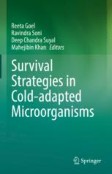Search
Search Results
-
Photosynthetic Acclimation and Adaptation to Cold Ecosystems
Cold-tolerant, photosynthetic organisms are able to either acclimate or, alternatively, adapt to low temperatures. The former are designated as...
-
Deciphering the Cold Adaptive Mechanisms in Pseudomonas psychrophila MTCC12324 Isolated from the Arctic at 79° N
Psychrophiles, host of cold environments, have been successfully undergoing the process of evolution by which they have acquired innate adaptations...

-
Cold-Adapted Microorganisms and their Potential Role in Plant Growth
Abiotic and biotic factors typically interact with each other and are the primary determinants of the agricultural yield especially for the...
-
Novel Insights into Environmental Niche Adaptations and Secondary Metabolite Biosynthesis Potential of Marine Sponge Microbiome
The microbial diversity of the sponge differs from a very rich non-polluted site to polluted sites; it is unclear whether the intra-species variation...
-
Extremophile enzyme optimization for low temperature and high salinity are fundamentally incompatible
The evolutionary mechanisms behind cold and high-saline co-adaptation of proteins are not thoroughly understood. To explore how enzymes evolve in...

-
High salt-induced PSI-supercomplex is associated with high CEF and attenuation of state transitions
While PSI-driven cyclic electron flow (CEF) and assembly of thylakoid supercomplexes have been described in model organisms like Chlamydomonas...

-
Improved strategies to efficiently isolate thermophilic, thermotolerant, and heat-resistant fungi from compost and soil
Thermophilic, thermotolerant and heat-resistant fungi developed different physiological traits, enabling them to sustain or even flourish under...

-
Perspectives for using glacial and periglacial microorganisms for plant growth promotion at low temperatures
Even though they are among the most extreme environments in which life can develop, glaciers are colonized by metabolically active microbes, some of...

-
Growth and rapid succession of methanotrophs effectively limit methane release during lake overturn
Lakes and reservoirs contribute substantially to atmospheric concentrations of the potent greenhouse gas methane. Lake sediments produce large...

-
Bacterial Communities of Microbial Mats of the White Sea Supralittoral and of the Littoral of the Lakes Separated from the Sea
Abstract —Conditions of formation and phylogenetic composition were studied for pigmented biofilms and microbial mats of the Kandalaksha Bay (White...

-
Environmental Constraints That Limit Methanogenesis
Methanogens are active in many different ecosystems, including habitats with biologically-derived organic matter as substrates such as aquatic...
-
Harnessing the sponge microbiome for industrial biocatalysts
AbstractWithin the marine sphere, host-associated microbiomes are receiving growing attention as prolific sources of novel biocatalysts. Given the...

-
Microbial Communities Responding to Deep-Sea Hydrocarbon Spills
The 2010 Deepwater Horizon oil spill in the Gulf of Mexico can be considered the world’s first deep-sea hydrocarbon spill. Deep-sea hydrocarbon...
-
Computational discovery and annotation of conserved small open reading frames in fungal genomes
BackgroundSmall open reading frames (smORF/sORFs) that encode short protein sequences are often overlooked during the standard gene prediction...

-
Microbial Communities Responding to Deep-Sea Hydrocarbon Spills
The 2010 Deepwater Horizon oil spill in the Gulf of Mexico can be considered the world’s first deep-sea hydrocarbon spill. Deep-sea hydrocarbon...
-
Chilling out: the evolution and diversification of psychrophilic algae with a focus on Chlamydomonadales
The Earth is a cold place. Most of it exists at or below the freezing point of water. Although seemingly inhospitable, such extreme environments can...

-
Genomics of Psychrophilic Bacteria and Archaea
Genomes are available for a wide range of psychrophilic bacteria and archaea. As of early 2017, approximately 130 cold-adapted species have genome...
-
Differential gene content and gene expression for bacterial evolution and speciation of Shewanella in terms of biosynthesis of heme and heme-requiring proteins
BackgroundMost species of Shewanella harbor two ferrochelatase paralogues for the biosynthesis of c -type cytochromes, which are crucial for their...

-
Fungi between extremotolerance and opportunistic pathogenicity on humans
Numerous agents of infections in humans and other mammals are found among fungi that are able to survive extreme environmental conditions and to...

-
Environmental Adaptation from the Origin of Life to the Last Universal Common Ancestor
Extensive fundamental molecular and biological evolution took place between the prebiotic origins of life and the state of the Last Universal Common...

